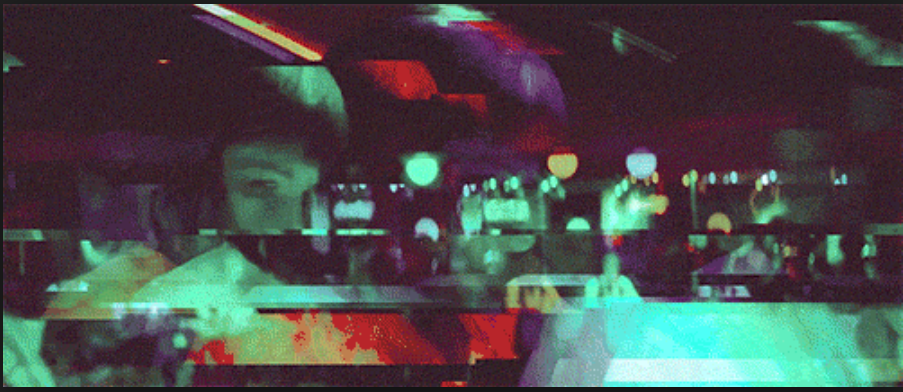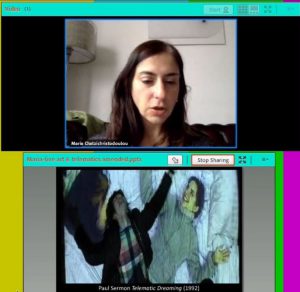//._ insert glitch art gif.
Undoubtedly, this has been the first online symposium I’ve attended.
I am a big fan of watching artist livestreams, artists talking while drawing and also giving industrial tips and design. I learn quite a bit from these livestreams, it feels as if the artists are guiding us through a tutorial and gently helping us on the way. The interaction and information flows both ways, allowing the learning artists and the performing learned artist to feel some sort of kindred comfort and connection in the third space.
In this symposium, however, the flow of knowledge and information is not just top down and didactic. I was amazed and inspired by the “globally distributed democratic community” telematically connected through the internet, discussing, debating, and supporting the conversation.
With each new piece of information the main speaker Maria gives, other speakers will chime in on scholarly comments of personal interpretation of that project.
From the symposium, I learnt different notions of interactivity. It is a real time artwork, which “carries a promise and taints an ideology, or produces a feeling of liveness”. Being live, it is open to interruptions, and can “potentially interrupt and affect one another in a shared moment”.
I felt that this truly conveyed how information and opinions would be exchanged in this post globalized world.
In this post globalized world, we are faced with an exponential increase in interconnectivity and interconnectivity between countries and people. Thusly, we are faced with the varied multiplicity of opinion and perspectives, which fragment our conventional linear narrative of the truth. Speaker Maria brings out the term “Internationalism”, which is a distributed global practice, but notes that it’s also important to consider the transmission node locations.
In this new world state, we should aim to create a multithreaded narrative of the truth, one which encompasses many narratives, views and perspectives.
That’s where the symposium works best. In creating an open space in the third space, all people are invited to participate in a unilateral, egalitarian exchange. No one is hindered and rejected from the main narrative on the basis of inaccessibility, background and belief.
It can be almost described as an ideological arena where ideas fight for respect and to he heard based on their own merits alone. A truly egalitarian meritocracy, not undermined by the pressures of bureaucratic mazes and oligarchy. This media of ideological excellence and elitism, which is also a welcoming arena of diversity, is a direct challenge to mainstream media, especially television, says speaker Maria.
Speaker Maria brings up Gene Youngblood, who first proposed for video to be considered an art form. On the topic of “being and Connectedness in Telematic Space”, we learn that telematicness is defined as live/liveness and interactivity; tackling response-ability, and the ethics of an encounter. It can establish links between two remote spaces of the same time in a single performance event in the third space. It is the “most common digital performance of our time”.
These traits are not present in recorded media.
ANNIE ABRAHAMS
LIVE NETWORKED PERFORMANCE
Eggcellent.
3 milliseconds
Take me to your leader
My friends commented that their mutterings seemed so unsynced yet so synced, giving a therapeutic atmosphere, especially after the frenzied not taking just now.
We could pinpoint performance mistakes, like the dude trying to find a white wall but unable to do so in time, but the surreal inconsistency of the performance created a sense of cohesion
“You are my only hope obi wan kenobi!!”
At a certain point, I felt that their words resembles movie quotes. I led me to presume that the performers are each like computers or technologies trying to learn though existing knowledge and spreading information to others.
Annie Abrahams brings up “Computer slave labour”, supporting my insight.
“I almost feel as if we are neural nets being trained with various iterations of standard objects, as a reference library. The repetitive verbal cues sound like training signals”, “there’s an odd calmness here, as if they’re dream images or freud’s magic slate at work”, she says.
The performances in the two days showed different levels of intimacy. On the first day, it was more of a didactic, top down way of conveying ideas or feelings, given the nature that Annie Abraham’s performance like a recorded lecture with the intent of showing, teaching and conveying different things.
However, the performance on the last day felt scantily intimate, given the voyeuristic camera angles and movements. Different camera angles gave a wider perspective of the performance, increasing our immersion in the scene. The illicit performances of bdsm and leeches showed a very raw, human side to our nature.
I felt nerved watching them, and found myself averting my eyes often. The sense of wrongness seemed to pervade me and sink in me, making me feel wholly uncomfortable. To be frank, it was not the sensualistic deviancy which caused my aversion. Rather it was the sticky feeling of the skin, feeling as if in that moment i am watching them, i am a part and participating in their ritualistic movements. I t almost feels that i am both spying on them and watching something that i am not supposed to, and yet at the same time, part and parcel of their being and actions.
Upon reflection, I realized that i was truly feeling connected to the performers in the third space. So much so that the level and degree of intimate understanding and connectedness drove me into the feeling of the uncanny valley. The uncanny valley is a common unsettling feeling people experience when androids (humanoid robots) and audio/visual simulations closely resemble humans in many respects but are not quite convincingly realistic. To interact and be with something that feels so viscerally real and yet is not made me step back and distance myself. Perhaps it is my body telling me that the manufactured feeling of closeness was so unique, rare and new that I should be wary and afraid of it.
We humans are wholly accustomed to seeing manufactured feelings of intimacy, though movies, theater and books, where we feel a kindred connection to the imaginary people. However, we can still differentiate that we are not part of their narrative and we can distinguish ourselves from being too entangled in fiction. I it think it scares us to see, feel and believe in manufactured realities as shown in the performances. Perhaps its because we would find it so realistic that we cannot easily disentangle ourselves from it.
My peer brought out that the presence of helpers/assistants draws attention to the ecological nature of interconnected life forms: human/animal, human/internet, internet/animal.
I believe that this causes the performance to have a much deeper resonance as it touches on core issues that are deeply felt and relatable.
From this symposium, I’ve learnt that in this entanglement between machines and people we can make something. After all, we all inhabit a sense of interconnectedness. Coming together in this symposium is to have an experience to join us all in collective spirit, learning and endeavors.

